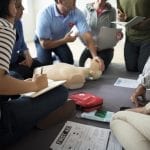We all know the importance of learning CPR in case we come across the unfortunate event of someone in sudden cardiac arrest. But what if that person is you? Who will be there save YOUR life? As a mother who spends most of the time at home alone with our two small boys, I sometimes wonder “what if that happens to me?” Our sons are 2.5 and 4.5 – perhaps not quite old enough to administer life-saving techniques, but that doesn’t stop us from teaching them the skills. At a much younger age they were already crawling onto our chests to do compressions and give us mouth to mouth…anytime they saw us laying down! Now their cousins know about CPR, too, which is a good place to start at their young age. I was in college before taking my first CPR class and truly understanding the basics of CPR. If our children are familiar from a young age with the signs of someone in distress and the steps to save their life, these skills should become second-nature to them.
- “Is mom napping or not breathing??” Would your child know the difference? Demonstrate to them how to check for breathing and responsiveness by tapping and shouting.
- What next?? Even if they are unsure of the situation, it is best for them to get help. Depending on their level of ability and access to a phone, they should be comfortable with dialing 911 or running to the nearest, trusted neighbor for help (who should then call 911). The 911 dispatcher should be able to talk your child through what to do.
- If your child recognizes that you are not breathing, they should roll you flat on your back and begin chest compressions. Continue compressions until help arrives!
Basic safety and first aid should be part of your family’s preparedness in case of an emergency, no matter how big or small. Have a list of your local emergency contacts on the refrigerator. Make sure your first aid kit is accessible and ready to use. Have a plan of action for any situation!

